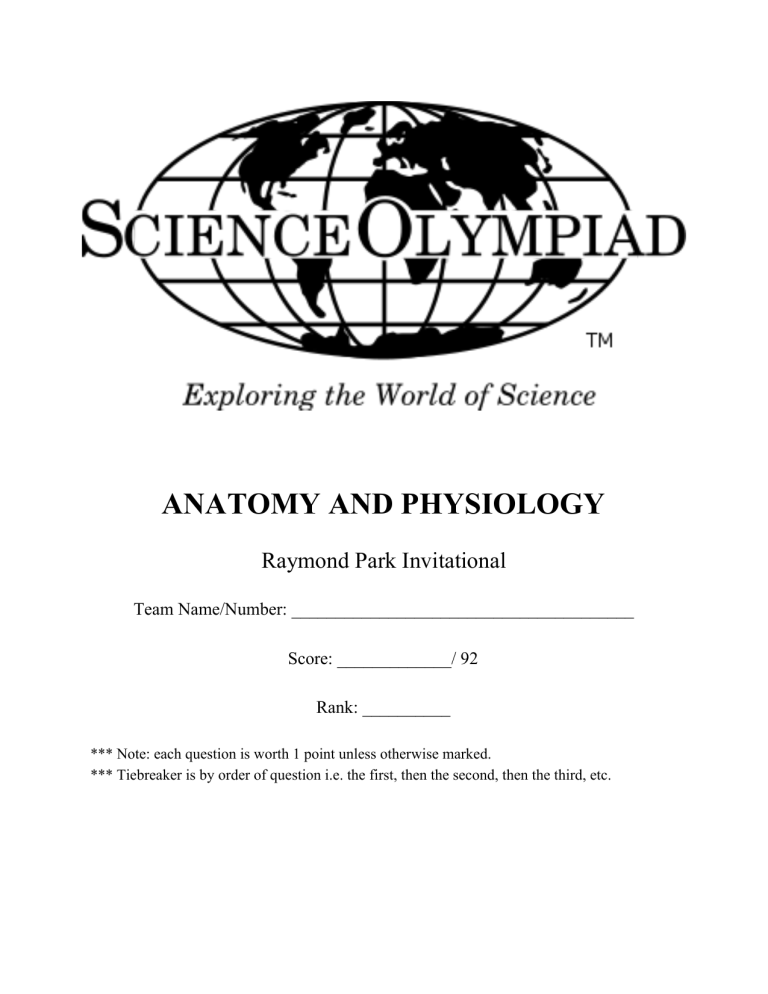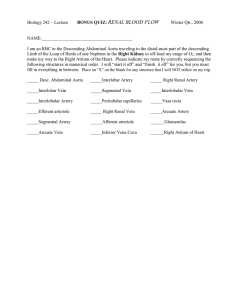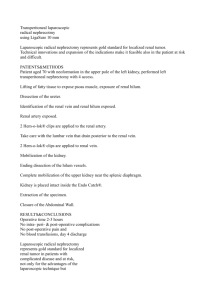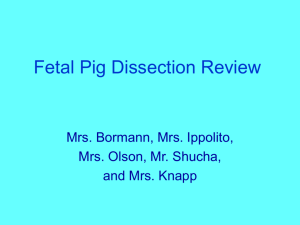
ANATOMY AND PHYSIOLOGY Raymond Park Invitational Team Name/Number: _______________________________________ Score: _____________/ 92 Rank: __________ *** Note: each question is worth 1 point unless otherwise marked. *** Tiebreaker is by order of question i.e. the first, then the second, then the third, etc. 1. The clearance ratio of what substance is exactly equal to GFR? Insulin 2. How does the Fick principle apply to the kidney? a. The amount of substance entering the kidney via the inferior mesenteric artery is equal to the amount of substance leaving the kidney via the renal vein plus amount excreted in urine b. The amount of substance entering the kidney via the renal vein is greater than the amount of substance leaving the kidney via the renal vein plus amount excreted in urine c. The amount of substance entering the kidney via the renal vein is equal to the amount of substance leaving the kidney via the renal vein plus amount excreted in urine d. The amount of substance entering the kidney via the renal vein is equal to the amount of substance leaving the kidney via the renal vein 3. During normal development, an orderly sequence of events occurs.Choose the answer below that orders (from first to last) the following developmental events correctly: 1) Formation of the last nephron in the definitive kidney 2) Appearance of somites 3) Appearance of the ureteric bud 4) Appearance of the uterine tube a. 2-4-1-3 b. 2-3-4-1 c. 2-4-3-1 d. 3-4-1-2 4. What percent of cardiac output do the kidneys receive? 25% 5. Regarding the control of water balance by the kidneys: a. The renal medulla has an osmotic gradient that decreases from the border with the cortex to the renal papilla b. ADH is secreted by the anterior pituitary in response to a decrease in the osmolality of the blood c. A normal person cannot produce urine with an osmolality greater than 300 mOsmol.kg-1 d. ADH acts on the P cells of the collecting ducts to increase their permeability to water 6. The function of the nephron loop of Henle is to: a. Create a longitudinal medullary concentration gradient in the kidney b. Concentrate urine c. Maintain the longitudinal medullary concentration gradient d. Reabsorb most of Na+ and Cl− that is reabsorbed by the kidney tubules e. All of the above 7. At any given level along the ascending limb of the loop of Henle, the osmolarity of the fluid in the lumen is __________ the osmolarity of the surrounding interstitial fluid. a. lower than b. equal to c. higher than 8. The lowest concentration of plasma glucose that will give rise to the excretion of glucose in urine is approximately: 200 mg/dL 9. The main barrier precluding the free passage of albumin across the glomerular capillary walls is formed by: a. the fenestrated glomerular endothelium b. anionic proteoglycan clusters within the glomerular basement membrane c. the filtration slits in between visceral epithelial cells (podocytes) d. none are correct 10. Concerning angiotensin II: a. the exocrine renin-angiotensin-aldosterone system includes angiotensinogen production by the liver, renin secretion by the juxtaglomerular apparatus and angiotensin-converting enzyme present at the luminal surface of endothelial cells b. aldosterone, but not AII, stimulate thirst and salt appetite c. angiotensin II induces marked increases in sodium reabsorption by the loop of Henle and the collecting duct d. A and C are correct e. all are correct 11. All of the following occur within one hour of eating a large acid load EXCEPT: a. the acid load is immediately buffered by intracellular proteins and phosphates as well as extracellular bicarbonate b. the lungs will begin eliminating CO2 generated as a result of the acid load c. the kidney will eliminate all the nonvolatile acids and regenerate bicarbonate to replace all the bicarbonate used in buffering d. hemoglobin will buffer some of the protons 12. The glomerular filtration barrier is composed of all the following except: a. fenestrated capillary endothelium b. macula densa c. basement membrane d. Podocytes e. mesangial cells 13. H+ secretion in the distal nephron is enhanced by all the following except: a. an increase in the level of plasma aldosterone b. an increase in the tubular luminal concentration of poorly reabsorbable anions c. Hyperkalemia d. metabolic acidosis e. respiratory acidosis 14. Urinary volume is increased by all the following except: a. diabetes insipidus b. diabetes mellitus c. sympathetic stimulation d. increased renal arterial pressure e. infusion of mannitol 15. The effect of antidiuretic hormone ( ADH ) on the kidney is to: a. increase the permeability of the distal nephron to water b. increase the excretion of Na+ c. increase the excretion of water d. increase the diameter of the renal artery 16. What are the two basic functions of the lymph nodes? (2 points) Cleansing the lymph and immune system activation 17. Which of the following are primary lymphoid organs? a. Mucosa-associated lymphoid tissue b. Thymus and red bone marrow c. Spleen and appendix d. Lymph nodes 18. What tonsils are most likely to get infected? Palatine tonsils 19. Fill in the blanks: The outer cortex mainly comprises of __________ cells, and the deep cortex comprises of ____________ cells, and the medullary sinus mainly consists of ________ cells. (3 points) B;T;B/Plasma 20. What is the cisterna chyli? Distended portion of the thoracic duct in the abdomen where the lumbar trunks and intestinal trunks empty into the thoracic duct 21. 48-year-old Margaret was unfortunately diagnosed with breast cancer. The doctor recommended a single mastectomy that removed her right breast tissue as well as some axillary lymph nodes adjacent to that tissue. A few months after her surgery, Margaret started to see unnatural swelling of her right arm. Explain your diagnosis of her condition and why it occurs. (3 points) Lymphedema (1 point)Removal of lymph nodes reduces rate of filtering and transport of lymph in that area, causing a “back up” of lymph in the vessels (1 point), resulting in edema. (1 point) 22. The spleen behaves similarly to the ____________ but instead of filtering ___________ it filters the ____________. a. Lymph node; lymphatic fluid; blood b. Renal node; lymphatic fluid; blood c. Lymph node; blood; lymphatic blood d. Renal node; urethra; blood 23. Where, specifically, are red blood cells processed? a. Red pulp b. PALS c. White pulp d. Hilum 24. While in the thymus, the lymphocytes do not respond to pathogens and foreign agents. True/False 25. What induces movement of lymph fluid throughout the body? a. Gravity and skeletal muscle contractions b. Muscle contractions and gravity c. Pressure changes caused by breathing and gravity d. The beating of the heart and gravity e. Muscle contractions and pressure changes caused by breathing 26. From where to where does lymph move? a. Interstitial spaces to subclavian veins b. Subclavian veins to interstitial spaces c. Organ cavities to subclavian veins d. Subclavian veins to organs e. It goes anywhere - not one-way 27. What happens in the lymph nodes as lymph flows through them? a. Reticular fibers filter out debris b. Foreign substances are filtered c. Plasma and mature T cells are added d. White blood cells are made e. A, B, and C are correct 28. What hormone does the thymus produce that stimulates the maturation of lymphocytes in other lymphatic organs? Thymosin 29. Which of the following diseases is caused by a parasite? a. LAM b. Elephantiasis c. Edema d. Hodgkin’s Disease 30. Which antibody accounts for 80-85% of serum antibodies, can cross the placenta, and is responsible for Rh reactions? a. igG b. igM c. igD d. igA e. igE 31. What are the three layers of the heart wall? Epicardium, myocardium, endocardium 32. What is the longest vein in the human body? Great Saphenous Vein 33. What is a hormone that is responsible for heart rate increases prior to and during an exercise period? Adrenaline or norepinephrine 34. When reading your blood pressure, a doctor usually says two numbers, “X over Y”. What are these two numbers? a. X = Ventricular Diastole | Y = Ventricular Systole b. X = Atrial Systole | Y = Ventricular Diastole c. X = Ventricular Systole | Y = Ventricular Diastole d. X = Ventricular Systole | Y = Atrial Diastole 35. Osmoreceptors from which brain region trigger thirst in response to depleted plasma volume? a. Pons b. Hippocampus c. Medulla Oblongata d. Hypothalamus 36. How does the body sense and respond to a hemorrhage? a. Arterial baroreceptors fire less rapidly, activating the parasympathetic nervous system to raise blood pressure b. Arterial baroreceptors fire more rapidly, activating the parasympathetic nervous system to raise blood pressure c. Arterial baroreceptors fire less rapidly, activating the sympathetic nervous system to raise blood pressure d. Arterial baroreceptors fire more rapidly, activating the sympathetic nervous system to raise blood pressure 37. In order for the heart to properly function, the atria need to contract before the ventricles so the blood in the atria can enter the ventricles to be pumped. What is the main mechanism the heart ensure that atrial contraction completes before ventricular contraction begins? a. The ventricle is much further away from the origin of the signal, and the increased conduction times as a result lead to a delay b. The ventricular myocardiocytes contract slower than atrial myocardiocytes c. The conduction signal gets delayed at the AV node before moving on to the ventricles d. The atrial extracellular fluid has a higher concentration of Na+ ions, leading to faster contractions 38. What is the hematocrit a measure of? a. The % of erythrocytes, leukocytes, and thrombocytes in the blood b. The % of erythrocytes and leukocytes in the blood c. The % of erythrocytes only in the blood d. None of the above 39. Where are action potentials originally generated in the heart? a. Right atrium b. Left atrium c. Right ventricle d. Left ventricle 40. Which of the following clotting factors is not involved in the intrinsic clotting pathway? a. Factor VII b. Factor IX c. Factor X d. Factor XI 41. In patients affected with atherosclerosis, which layer of the arterial wall is affected? a. Tunica adventitia b. Endothelium c. Tunica intima d. Tunica media 42. Hemoglobin in the R state has a(n) _____________ affinity to oxygen than hemoglobin in the T state a. Higher b. Lower c. Equal d. Variable Label the parts of the kidney according to the above diagram: A. Anterior Renal Fascia B. Perinephric fat capsule C. Paranephric fat capsule D. Renal hilum E. Renal sinus F. Fibrous capsule Score: 6/6 2. Label the parts of the lymphatic system according to the above diagram. A. Palatine Tonsil B. Submandibular node C. Cervical node D. Thymus E. Cisterna chyli F. Intestinal node G. Inguinal node H. Peyer’s patch I. Spleen J. Axillary node Score: 10/10 3. Heart A. Brachiocephalic trunk B. Left common carotid artery C. Left subclavian artery D. Ligamentum arteriosum E. Pulmonary trunk F. Aortic valve G. Interventricular septum H. Trabeculae carneae I. Papillary muscle J. Chordae Tendineae K. Conus arteriosus L. Pectinate muscles M. Right atrium N. Fossa ovalis O. Superior vena cava Score: 15/15 4. Vessels A. Cephalic vein B. Axillary vein C. Brachial artery D. Median cubital vein E. Radial artery F. Digital artery G. Peroneal artery H. Small saphenous vein I. Femoral artery J. Internal iliac vein K. Hepatic veins L. Pulmonary arteries M. Vertebral arteries N. Basilar arteries Score: 14/14



